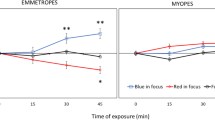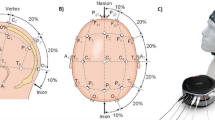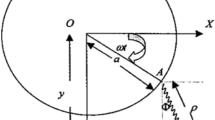Abstract
WHEN a simple harmonic pendulum is viewed binocularly with a neutral-tint filter in front of one eye, the pendulum, instead of swinging to and fro in a plane, appears to swing in an ellipse, first advancing towards and then receding from the observer1. The simplified but not quite true explanation of the illusion is that the 'latent period' of vision in the unobscured eye is shorter than that in the other eye, the brighter retinal image being followed by the shorter latent period. If with a pendulum swinging from right to left, both eyes fixate the true position in space of the pendulum, then the right eye will project the pendulum along a line to the right of the line of fixation whilst the left eye if obscured will project it along a line still more to the right of its line of fixation. The lines of projection will intersect at a point on the observer's side of the pendulum and this is the position in space which the pendulum will appear to occupy. Similarly it can be shown that the pendulum will appear to recede from the observer when passing from left to right and that its point will trace out an ellipse. Using a movable pointer beneath the pendulum, an observer can measure the apparent forward displacements with filters of varying densities in front of one eye and it is possible to calculate the difference in time (sec.) between the latent periods of the two eyes (Δ LP) for any given ratio between the retinal illuminations of the two eyes (Iu/I0). I find that the relation is 0·02 log10 Iu/I0 = Δ LP + c, where c is a small constant depending on the difference between the latent periods of the unobscured eyes. The relation holds accurately for any one illumination of the pendulum, but with any given filter ΔLPbecomes smaller if the illumination is considerably increased.
This is a preview of subscription content, access via your institution
Access options
Subscribe to this journal
Receive 51 print issues and online access
$199.00 per year
only $3.90 per issue
Buy this article
- Purchase on SpringerLink
- Instant access to full article PDF
Prices may be subject to local taxes which are calculated during checkout
Similar content being viewed by others
References
Pulfrich, C., Naturwiss., 10, 553 (1922).
Allen, F., J. Opt. Soc. Amer., 13, 383 (1926).
Author information
Authors and Affiliations
Rights and permissions
About this article
Cite this article
LYTHGOE, R. Some Observations on the Rotating Pendulum. Nature 141, 474 (1938). https://doi.org/10.1038/141474a0
Published:
Issue date:
DOI: https://doi.org/10.1038/141474a0
This article is cited by
-
Effect of Humming on Vision
Nature (1967)
-
Pulfricheffekt bei seitlicher Blendung
Arbeitsphysiologie (1954)
-
Messende Untersuchungen am Pulfricheffekt
Pfl�gers Archiv f�r die Gesamte Physiologie des Menschen und der Tiere (1950)
-
Optokinetische Raumwahrnehmung, ein neuartiges Prinzip
Pfl�gers Archiv f�r die Gesamte Physiologie des Menschen und der Tiere (1950)
-
Some Observations on the Rotating Pendulum
Nature (1938)



